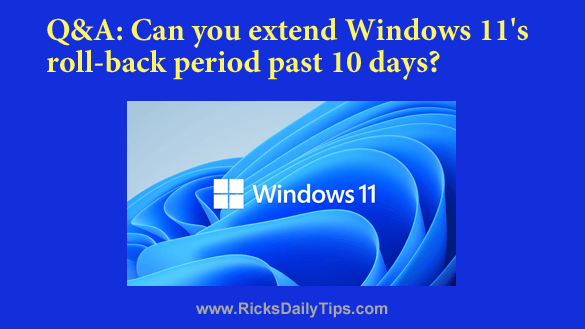 Question from Robbie: A couple of days ago I updated my PC to Windows 11 expecting to have 30 days to change my mind like we had when Windows 10 came out.
Question from Robbie: A couple of days ago I updated my PC to Windows 11 expecting to have 30 days to change my mind like we had when Windows 10 came out.
But then I found out the window for rolling Windows 11 back to Windows 10 is only 10 days, not 30.
The problem I have is I’m going out of town on business tomorrow and I won’t be back until after the end of the month.
By the time I return the 10 day roll-back period will have expired and I’ll be stuck with Windows 11 even if I end up not liking it.
Is there any way to extend the Windows 11 roll-back period to longer than 10 days (to something like a month)? If not I guess I’ll just roll back to Windows 10 before I leave town.
Rick’s answer: Yes there is, Robbie. All you have to do is rename the Windows.old folder on your PC’s C: drive to something else.
For example, you could rename the folder from Windows.old to Windows.preserved (or something similar).
What happens after the 10 day roll-back period has expired is Windows 11 will check to see if a Windows.old folder exists. If it finds one (and it will since you just upgraded to Windows 11) it will delete it to free up the storage space it’s using.
If you rename that folder to something else then Windows 11 won’t be able to find it and delete it. That means you’ll be able to wait as long as you need to before making the decision whether to stay with Windows 11 or not.
If you ultimately decide to roll your Windows installation back to Windows 10, simply rename the folder back to Windows.old and immediately initiate the roll-back process.
Important: Don’t wait to initiate the roll-back process or Windows 11 could detect the existence of the newly renamed Windows.old folder and delete it before you have a chance to do the roll-back. Do it just as soon as you finish renaming the folder.
Now all of the above being said, you do have a couple of other options for reverting back to Windows 10:
1 – If you created a System Image Backup or a backup using a third-party backup app prior to updating the machine to Windows 11 you can always simply restore the old operating system from that backup.
Truth be told, I recommend creating a System Image Backup before updating to Windows 11 anyway. After all, Windows Updates fail all the time.
2 – You also have the option of installing Windows 1o from scratch.
The advantage of this option is your machine would be starting over with the clean slate that always results from a fresh installation.
The disadvantages are you’ll lose any user-created files that are currently on your hard drive and you’ll have to reinstall your programs, apps, printers and everything else you installed prior to initiating the Windows 10 re-installation.
Bottom line: You can rename the Windows.old folder to prevent Windows 11 from deleting it, thereby preserving your option to roll back to Windows 10 for pretty much as long as you like.
However, one of the other options mentioned above might work better for you, depending on your situation.